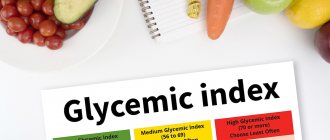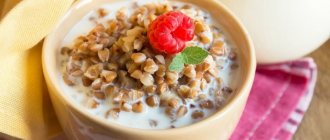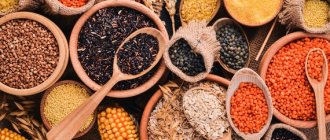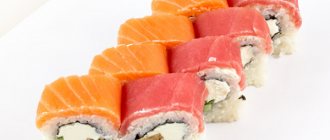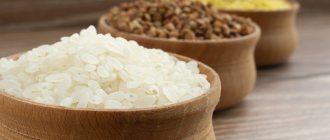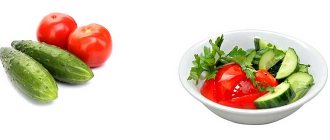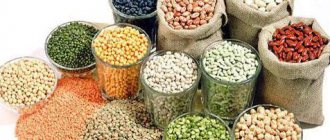We are what we eat. And most health problems are caused by poor nutrition. Take, for example, obesity and diabetes. These diseases go hand in hand. The first is a consequence of the uncontrolled absorption of all the most harmful, sweet and fatty foods, the inability to say to oneself “enough” and ignorance of the basic rules of creating a diet. And one of the factors influencing the occurrence of the second is a rapid increase in body weight. In this article we will tell you what the glycemic index of food is, explaining how it affects our well-being and figure.
Our additional services: Bioimpedance | Marutaka Massage | Pressotherapy | Ion-Detox
When health is at risk: a few facts
Under the definition, which all leading nutritionists talk about, is an indicator of the impact of the food we prepare or buy for ourselves on our blood sugar levels. It depends on the GI whether it goes off scale or remains within the normal range. Each product has its own number - from zero to one hundred. The higher it is, the faster food affects glucose levels, increasing it
Pure glucose has a glycemic index of 100. What does this mean? It gets into the blood instantly. Vegetables, fruits, semi-finished products, sweets, meat, fish, and pasta are compared with this indicator—let’s call it “the limit.” Everything that ends up on your table, and then into your stomach.
The news that there are foods with a low and a high glycemic index, and that the GI of foods has a direct impact on our health, has changed the position of nutritionists in relation to what diet is considered correct. Experts have made many discoveries. For example:
- Bread and potatoes can quickly raise blood glucose levels - just like a few pieces of refined sugar.
- Some foods that seem completely different have almost the same GI. Let's take donuts and watermelon. The index of the sweet delicacy that came to us straight from the confectionery shop is 76, and the largest false berry has a score of 75. Surprising, but true!
However, you should not judge the benefits or harms of a particular food by the glycemic index. If you do this, those same watermelons will be on the black list along with cakes and chips.
Not so simple. This figure alone cannot be blindly trusted. There is another indicator that helps to understand how high the glucose level will rise, and also how long it will last at our maximum level. We will tell you about it further.
Health formula: not only GI
Another definition we'll talk about is GL or glycemic load. It is not so difficult to calculate: just multiply the GI index by the amount of carbohydrates contained in the product and divide the result by one hundred.
So, for donuts the load will be 29.5, and for watermelons - 5.1. This is what needed to be proven: with flour products we will receive several times more glucose than with one of our most favorite summer treats.
Why is this indicator needed? It becomes an excellent confirmation that it is necessary to take into account not only the glycemic index. After all, if we choose a product with a low GI, but high in carbohydrates, then we will gain weight twice as fast.
How to keep the situation under control? We offer you the following option: constantly monitor your GN, choose foods with a low index, or limit your carbohydrate intake.
At the same time, we cannot completely forget about these useful organic substances. Remember that there are two types: fast and slow. The former should be excluded from the diet, but the latter can be left - but in moderation.
What is the glycemic index?
The glycemic index measures how quickly insulin and blood sugar levels rise after eating a food (glycemic response). Glucose is the main sugar found in the blood and is the main source of energy. The glycemic index ranks foods on a scale from 0 to 100, using pure glucose with a score of 100 as the standard.
For people with diabetes (a disease in which blood sugar levels are already too high), the GI score is an important tool to help control blood sugar levels. Healthy people would also do well to take this indicator into account. Why? If you follow a low GI diet, you'll feel full faster and consume fewer calories because low GI foods tend to take longer to digest and won't cause a spike in blood sugar.
What's good and what's bad: low glycemic index nutrition
Nutritionists have divided GL levels into several categories:
- The optimal indicator is no more than 10.
- Average – over 11 and up to 19.
- High – more than 20.
The glycemic load per day should not exceed the norm - 100 units. This warning is true for a healthy person who takes care of himself and eats right.
However, both GBV and GI can be outsmarted. Why and how? The index is influenced by heat treatment - the form in which a particular product enters our stomach. And here's what you can do to help yourself get rid of extra numbers and excess weight:
- The more industrially processed, the higher the glycemic index. If you don’t want to gain new kilograms, and with them new diseases, give up processed foods and switch to natural foods. Example: in front of you is instant mashed potatoes and simple boiled potatoes. A semi-finished product has an index of 90, while something made at home has an index of 65. The difference is obvious.
- Culinary (heat) processing also affects GI, causing it to increase. So, stewed cabbage has an index of 15, and fresh cabbage has an index of 10. What to do? Is it really possible to give up the usual ways of preparing your favorite dishes and eat raw vegetables? If thermal exposure is unavoidable, keep it minimal. In boiled food, many valuable nutrients and organic compounds are destroyed - for example, vitamin C, fiber.
- Products that have a low glycemic index and contain a maximum of beneficial vitamins, minerals and amino acids - what are they? This is all that contains coarse fibers in large quantities. The more there are, the better for you and the lower the indicator.
- How to eat fruits and vegetables to retain their beneficial properties if heat treatment deprives them? Consume the gifts of nature along with the peel - it contains so much fiber, on which the GI depends.
- Another interesting fact: the more the product is crushed, the higher its glycemic index. For example, let’s take soft and fluffy buns made from white flour - fresh from the oven, as well as a tea loaf and bread made from wholemeal flour. The first indicator is 95, the second is 70, and the third is 50. Rice can be compared in the same way - polished and unpeeled (the first GI is 70, the second is 50). What can be concluded? If you want to maintain your health and figure, choose a product that has undergone gentle processing, or completely natural food - whole grain porridge, bran bread made from flour obtained after grinding grain once.
- Some interesting information about fruits: the more acidic they are, the lower the GI. It turns out that unripe apples are healthier than overripe ones.
How to reduce the indicator? You can use a little trick: prepare a dressing for salads from fresh vegetables or a spicy vinegar-based marinade.
Should the diet really only contain foods with a low glycemic index, and the rest should be prohibited? Don't go to extremes. When creating a menu for every day, do not exclude any dish, focusing only on GL or GI. It’s worth looking at the calorie content, because it is the energy value of the food we eat that determines whether we will gain weight or not. Don’t forget that your diet contains all the necessary vitamins, minerals, and amino acids.
Why then is the concept of glycemic index given? Knowing it, you can adjust and regulate the daily GL. Here are the main values used by nutritionists:
- The level we are used to is between 60 and 180.
- An indicator not exceeding 80 can be considered too low.
- The average number is from 80 to 119.
- Increased load – from 120.
If you suffer from excess weight or diabetes and are forced to monitor the amount of carbohydrates consumed and blood sugar levels, you need to create a daily diet so that the total GI does not exceed 100 units.
Where can I find information about the glycemic index of a product?
The glycemic index of foods is best checked in special tables, for example, in scientific studies.
Food products were divided into three categories:
- foods with a low glycemic index, where IG 55
- foods with an average glycemic index, where IG is 56 - 69
- foods with a high glycemic index, where IG 70
It should be remembered that depending on the source, the glycemic index of individual foods may vary due to many factors influencing this parameter.
Examples of zero GI foods:
Vegetable oils, butter, eggs, cheese, poultry, pork, veal, beef, salmon, cod
Examples of low GI foods:
- Gooseberry (15)
- Wholemeal rye bread (50)
- Skinny cottage cheese (30)
- Dark chocolate (22)
- Grapefruit (25)
- Green peas (48)
- Pear (38)
- Apples (38)
- Apple (38)
- Natural yogurt (36)
- White cabbage (15)
- Red cabbage (15)
- Chinese cabbage (15)
- Buckwheat (54)
- Buckwheat (54)
- Canned corn (55)
- Tangerines (30)
- Raw carrots (16)
- Skim milk (32)
- Whole cream milk (27)
- Cucumber (15)
- Nuts and almonds (15)
- Pepper (15)
- Mushrooms (15)
- Oranges (42)
- Tomato (15)
- Leeks (15)
- Cooked brown rice (55)
- Radish (15)
- Iceberg lettuce (10)
- Strawberry (40)
- Cherry (22)
- Examples of products with average IG:
- Pineapple in a tin (65)
- Fresh pineapple (59)
- Chocolate bar (44-65)
- Beetroot (64)
- Boiled pasta (61)
- Boiled carrots (47)
- Muesli (59)
- Raisins (64)
- White boiled rice (64)
- Black grapes (59)
- Boiled potatoes (69)
Examples of high GI foods:
- Watermelon (72)
- Baguette (99)
- Potato chips (90)
- Wheat bread (70)
- Dried dates (103)
- Pumpkin (75)
- French fries (75)
- Millet (71)
- Pearl barley (70)
- Gluten free corn noodles (78)
- Corn flakes (81)
- Jelly beans (78)
Glycemic index and calorie content of food: table
Below are the values for vegetables.
Compare them - this will help you choose the most useful and easy ones for a perfectly slim figure. Don’t forget about proper nutrition, monitor the GL and energy value of your meals - this will bring you closer to the desired volumes and help consolidate the result.
The lowest indicators are for vegetables that have not undergone heat treatment. Draw conclusions: plant foods are the basis of the diet, but the thermal effect should be gentle.
This far from complete table contains a list of foods with a low glycemic index (GI) for weight loss. However, you should not put this indicator at the forefront. Do not forget:
- The calorie content of what we eat is of decisive importance.
- Proper nutrition cannot be monotonous and meager (for example, only vegetables or fruits).
- The list is not given so that you limit yourself, but so that your diet is complete and your menu is varied and balanced.
Which foods have a low GI?
Low glycemic index foods include those with a value below 55:
• Products with GI 50
Persimmon, mango, orange, kiwi, figs, natural juices from cranberries, blueberries, pineapple, meat and fish cutlets, pork schnitzel, fried beef liver, boiled eggs, scrambled eggs, brown rice, black coffee without sugar.
• Products with GI 45
Borodino and whole grain bread, grapefruit juice, vermicelli, cranberries, grapes, bananas, coconut, dry wines.
• Products with GI 40
Canned green peas, eggplant caviar, basmati rice, buckwheat, durum pasta, dry legumes, crab sticks, carrot juice, prunes, dried apricots, chicory.
• Products with GI 35
Low-fat yogurts, fresh green peas, boiled sausage, chickpeas, wild rice, Chinese noodles, sesame seeds, quince, plum, apple, soy sauce.
• Products with GI 34
Pomegranates, peaches, nectarines, tomato juice, sugar-free compotes.
• Products with GI 30
Chicken, low-fat cottage cheese, soy milk, green beans, lentils, beets, tomatoes, garlic, pear, apricot, grapefruit, tangerines, passion fruit, lingonberries, blueberries, blueberries, jams with sweeteners, dark chocolate.
• Products with GI 25
Crushed peas, pumpkin seeds, red currants, strawberries, raspberries, gooseberries, cherries, soy flour, kefir.
• Products with GI 20
Dark chocolate with 85% cocoa content, eggplants, lemons, artichokes, seaweed, soy yogurt, cocoa powder.
• Products with GI 15
Celery, white cabbage, cauliflower and Brussels sprouts, olives, spinach, black currants, fresh and pickled cucumbers, soybeans, tofu cheese, almonds, pistachios, cashews, hazelnuts, peanuts, zucchini, radishes, rhubarb, hot peppers, mushrooms, leeks and onions, kefir, bran.
• Products with GI 10
Green salad and peppers, sunflower seeds, avocado.
• Products with GI 5
Parsley, oregano, hard cheeses, shrimp, crayfish, oysters and mussels, dill, vanillin, cinnamon.
A glycemic index of up to 55 is considered low only for foods. For a daily diet, this value is lower - up to 45. This indicator was derived from the American Diabetes Association.
A diet with a glycemic index of up to 45 is considered therapeutic and improves the well-being of people with diabetes.
